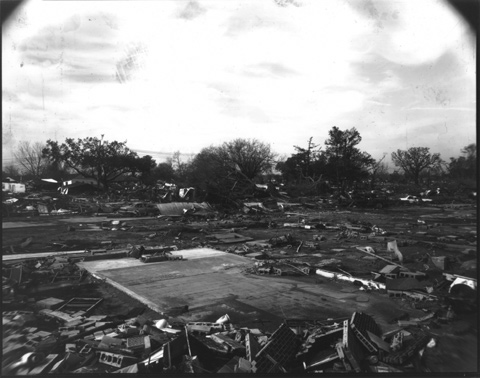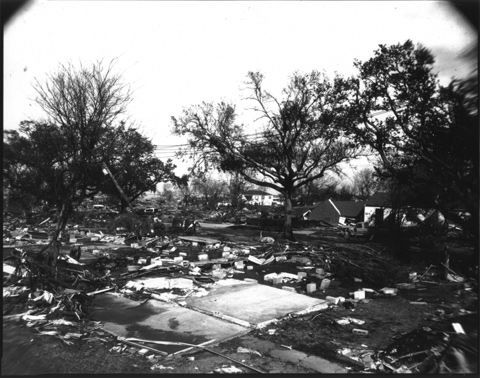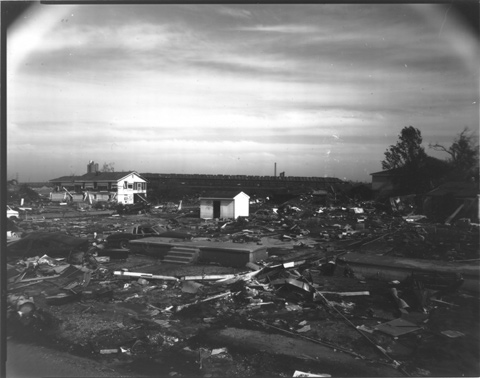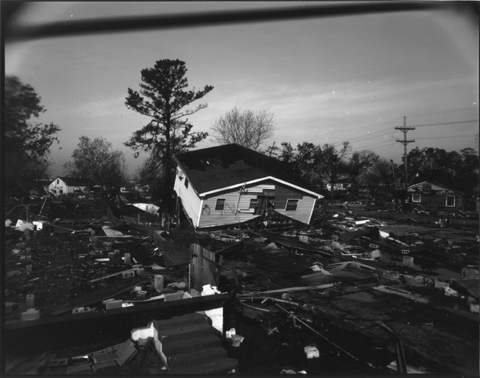Where were you when the levee broke?
Ironically, I was on the west coast and several weeks away from returning
to Louisiana. I had moved to Shreveport (a decaying oil boomtown in
northwest Louisiana) in January 2005 to set up a studio, finish editing
a film, and snoop around. An old friend, David Nelson, had moved back
home to Shreveport to rehabilitate an historical building downtown that
had once been an infamous blues joint called the Zebra Room. David now
runs a micro cinema and music venue there called Mini-Cine where he
hosts touring filmmakers and bands—bringing some culture form the
outside world into sleepy Shreveport.
Shreveport, like most of the once-wealthy
towns in the oil patch, had boomed with the discovery and development
of oil and gas fields in the early 1900s. In fact the world's first
off-shore oil well was drilled on Caddo Lake near Shreveport.
next... /
/ back...
Eventually
the fields were pumped mostly-dry and the energy companies moved to
Houston, TX. Then the crash of the global oil market in the 1980s delivered
the final, cruel blow to Shreveport's withering economic and civic
life. The downtown is now nearly a ghost town. The fair-weather fortunes
of petroleum deposits are ultimately indifferent to the people who happen
to live on top of them—in Persia or in the Old South. It was with
this history in mind that I began exploring—looking for stories that
might fit into a wide-ranging project I was developing based on ecological
collapse and the end of the oil age. I was planning to get back to work
with my old, wooden 8 x 10 camera to do some black and white landscape
photography there.
Then Katrina happened. I had a weird
feeling that one chapter of my project had just happened in real life.
The Katrina disaster has many contributing factors—some more easily
discernable than others. At the top of the list are the long-term effects
of the oil business on Louisiana's chopped-up coastal landscape and
on her famously corrupt local politics. Add to that the rising sea levels
and the hopped-up hurricanes feeding off hotter gulf waters (just cosmic
side effects of burning all that wonderful, God-given, carbon-rich oil).
I arrived in New Orleans in November
2005 and looked up film friends who were still hanging on. Rene Brossard
had lost his house, including all his video masters and the computer
that held his current piece. But the building that housed his 20-years-running
independent cinema, Zeitgeist, was undamaged.
next... /
/ back...
So in a city with no other
operating cinema, Rene re-booted his iconoclastic screening series and
audiences quickly began showing up in bigger numbers than before the
storm. Videomaker Courtney Egan and her husband were lucky—their house
in Irish Gulch was dry. Unlucky was hand-process film queen Helen Hill
and her husband Paul Galiunas. Their photo blog shows them digging out
sludge-ruined films, projectors and musical scores. It's awful when
anyone looses all their earthly possessions, but perhaps it is worse
for artists.
In going down to New Orleans, my goals
were to shoot some film, video and photos, and to check out Common Ground—an
activist-led relief organization that sprang to life the day after Katrina
struck. Activists from all over the country have converged on New Orleans
and set up medical and legal clinics, volunteer centers and tool libraries.
I won't attempt to describe the Common
Ground story, but I recommend checking out their website: www.commonground.org.
I did a benefit screening for CG of my hobo graffiti film at Zeitgeist,
and started hanging out at the CG volunteer compound in the 9th ward.
I spent a couple of days helping with some miscellaneous tasks and running
some errands for the building rehab efforts, like making an emergency
run to the just re-opened Home Depot to pick up seven more wheelbarrows
for an all-hands-available house-gutting that would be the backdrop
for a national press event the next day. I had a van. Most of the activists
there did not have cars. There were big plies of communal bikes at the
volunteer center.
next... /
/ back...
I began shooting some rolls of 16mm film. My buddy,
artist Chris Sullivan, drove me and my Bolex in his beater Toyota van
up and down the streets of Bywater where the streets were lined with
endless piles of the heart-wrenching contents of emptied out houses.
I got shots of the infamous barge that
broke through the levee at the Industrial Canal, causing the breech
that sent a tsunami directly in to the lower 9th ward neighborhood.
For dozens of blocks the destruction was tremendous and deadly. The
remaining wreckage was mind-blowing, and weirdly graphic—"disaster
porn," they call it. When the water was finally pumped out of the
neighborhood there were a lot of houses sitting on top of cars. Yeah,
in case you never thought about it, houses are more buoyant than automobiles.
The weirdness and the vastness of the
physical destruction to the landscape tended to occasionally eclipse
the violence towards the people. The people are gone but the wrecked
buildings are still there. The individual tragedies are not easily photographed.
The spray-painted markings on the houses denote what was found in the
way of survivors—bodies and pets. The extensive, scrawled messages
concerning pets were really disturbing. There seemed to be more evidence
of interest in the well-being of pets rather than people.
The whole experience was overwhelming.
A numbness sets in—a dazed state,—while confronting these scenes.
In the course of a week I spent there around New Years 2006 I was able
to only shoot a couple dozen sheets of film, of which only half turned
out. I shot about 6 rolls of 16mm film and about 15 min of video. Considering
how vast the scenario is it's strange how little material I actually
came back with.
next... /
/ back...
The 8x10 negs were blown up to 40x60
inch prints. The images here on the web don't nearly convey the detail
or the punch of the big prints which carry a hint of narrativity through
their blunt record of the bizarre landscape—living neighborhoods transformed
into future-fiction dead worlds.
Hurricane season has started again and
our global bad-weather ride is just beginning.
News on my project, Sunset Scavenger,
can be found at: www.billdaniel.net.
Photography and article by Bill Daniel.






